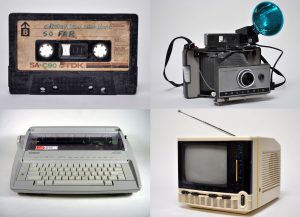
The Ad Guys are Wrong! Less Targeting, More Bonding
“Advertising is all about being in the right place, at the right time, with the right audience.”
In 1980, it became evident that technology gave the ability for advertisers and brands to target audiences. Using technology, they’d greater their odds at being in the right place, at the right time. In the 80’s, targeted ad tech came in the form of cable television, time-targeting and sociodemographics. It was the worlds first experience with toy commercials playing on cartoon networks or jewelry ad’s running on soap operas. It was advertising’s first foray beyond innocence.
Technology Changes Everything…
 As decades passed, technology has offered infinitely better tools. This technology has also given way to extremely advanced ad tech like search engine, social network and contextual targeting. Where it gets even more scary is behavioral, mobile and location-based targeting. Technology has allowed cameras and sensors to liter our world. Now programming code can accurately guess at emotional states and demographics.
As decades passed, technology has offered infinitely better tools. This technology has also given way to extremely advanced ad tech like search engine, social network and contextual targeting. Where it gets even more scary is behavioral, mobile and location-based targeting. Technology has allowed cameras and sensors to liter our world. Now programming code can accurately guess at emotional states and demographics.
What changed everything was the ability to instantaneously sift this data and make use of AI to make assumptions that are correct into the 80th percentile! Big data, in combination with advertising technology, allows retailers and brands to interact with you in very personal ways. Some find it amazing. Some find it incredibly cool. Others find it scary and an invasion of their privacy.
You can like it, you can use it, but you can’t fight it. When computers interact with each other, their’s no stopping progress. Technology has no emotions, and it doesn’t “think”. Advertising agencies will continue to make use of this technology and find ways at optimizing a client’s investment. Tomorrow is filled with programmatic buying and advanced ad-targeting. There’s just one problem…
Xennials and Millennials…

Baby Boomers have dominated the US markets since the 1950s. It was the largest generation of that time. They are a resilient, over-arching, generation that brought ideas of consumption and spending that no generation before or after has ever seen. Most of the modern world benefits from what was invented for, or by, baby-boomers.
The issue is that boomer’s are growing older…or dying. They are less and less part of the fabric that makes up US economics. They are retired, aging and no longer the prime focus of retailers and brands. Millennials and Xennials are now in the spotlight. These generations grew into technology and experienced adolescence in a shifting economy, with very mixed messages on consumption and self-sustenance. They are less impacted by messaging in general. They expect it…
“Expectance is like water on the fuze of disbelief…”
The problem with advertising to Xennials/Millennials is they aren’t elated with pertinent advertising. In many cases there is an assumption that ad’s were coming. These generations already investigated what is being sold, they don’t care about the targeted messages. But they have a weakness…
Emotional Intelligence…
 If you’ve interacted with a Millennial, (more-so than a Xennial) you’ll realize they are sorely missing emotional intelligence. They crave emotional connections. They portray themselves as “ironically unhinged”; a generation of cerebral thoughts and defiance. They pretend and mimic, confusing the people around them. The reality is, they seek approval. They want to be rewarded for creation and not consumption. They challenge authority and look for “fun” in everyday life. This fundamental shift directly impacts retailers, brands and the very fabric our economics. This is why Millennial’s are so important right now.
If you’ve interacted with a Millennial, (more-so than a Xennial) you’ll realize they are sorely missing emotional intelligence. They crave emotional connections. They portray themselves as “ironically unhinged”; a generation of cerebral thoughts and defiance. They pretend and mimic, confusing the people around them. The reality is, they seek approval. They want to be rewarded for creation and not consumption. They challenge authority and look for “fun” in everyday life. This fundamental shift directly impacts retailers, brands and the very fabric our economics. This is why Millennial’s are so important right now.
You cannot connect with a Millennial without speaking to their soul. Advertising technology has been built on the foundation of Boomers, and is far from what would be needed to create causation in a Millennial. Advertisers need to start over. Emotional messaging has a huge benefit over it’s targeted predecessor.
Human Nature…
 Emotional messaging is the goal. The benefit to emotional messaging is it isn’t time-based. It’s not tied to demographics or location. It’s the same whether it’s on TV, on mobile or within a social network. Emotional messaging is a universal language that almost everyone understands. For advertisers, this means they will always be in the right place, at the right time, with the right audience. The focus shifts. It’s now about story-telling. There will always be a need for brand recognition and general marketing. There will always be a need to target audiences. It’s not that this all goes away.
Emotional messaging is the goal. The benefit to emotional messaging is it isn’t time-based. It’s not tied to demographics or location. It’s the same whether it’s on TV, on mobile or within a social network. Emotional messaging is a universal language that almost everyone understands. For advertisers, this means they will always be in the right place, at the right time, with the right audience. The focus shifts. It’s now about story-telling. There will always be a need for brand recognition and general marketing. There will always be a need to target audiences. It’s not that this all goes away.
What shifts is the type of messaging. Millenials don’t care about advertising that is meant for them…they’re looking for more than the product being sold. They want to be associated with something. A movement. A message. They care about the reason behind what they’re using and wearing. It now becomes about why!
The Right Idea!
 Brands are becoming more aware of this shift. Take a look at Mission Belt, LACROIX, and Nike. These brands have become lifestyle brands. There’s millions of products that now associate with emotions and who you are as a person. Life is Good, Airstream, TopoDesigns…all companies that have a mission; they have a story for their patrons. The mission behind the company is what sells. The advertising is now about lifestyle and emotions. It pulls at deep life choices, not about where you are, or impulse buying.
Brands are becoming more aware of this shift. Take a look at Mission Belt, LACROIX, and Nike. These brands have become lifestyle brands. There’s millions of products that now associate with emotions and who you are as a person. Life is Good, Airstream, TopoDesigns…all companies that have a mission; they have a story for their patrons. The mission behind the company is what sells. The advertising is now about lifestyle and emotions. It pulls at deep life choices, not about where you are, or impulse buying.
If you’re an agency or creative company, your focus should be on the why. The emotional reasoning behind a product’s mission or message. Delve deep into the story…because technology doesn’t understand or care…it has no feelings, and that’s the currency of this generation.


